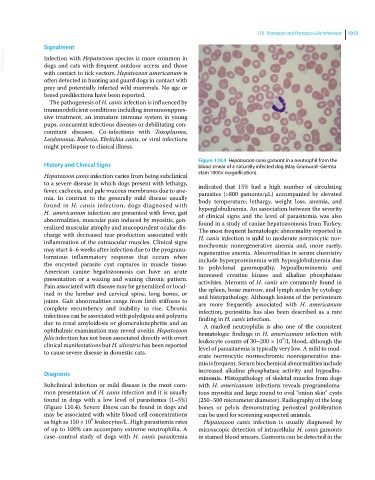Page 1075 - Clinical Small Animal Internal Medicine
P. 1075
110 Protozoal and Protozoa‐Like Infections 1013
Signalment
VetBooks.ir Infection with Hepatozoon species is more common in
dogs and cats with frequent outdoor access and those
with contact to tick vectors. Hepatozoon americanum is
often detected in hunting and guard dogs in contact with
prey and potentially infected wild mammals. No age or
breed predilections have been reported.
The pathogenesis of H. canis infection is influenced by
immunodeficient conditions including immunosuppres-
sive treatment, an immature immune system in young
pups, concurrent infectious diseases or debilitating con-
comitant diseases. Co‐infections with Toxoplasma,
Leishmania, Babesia, Ehrlichia canis, or viral infections
might predispose to clinical illness.
Figure 110.4 Hepatozoon canis gamont in a neutrophil from the
History and Clinical Signs blood smear of a naturally infected dog (May Grunwald–Giemsa
stain 1000× magnification).
Hepatozoon canis infection varies from being subclinical
to a severe disease in which dogs present with lethargy, indicated that 15% had a high number of circulating
fever, cachexia, and pale mucous membranes due to ane- parasites (>800 gamonts/μL) accompanied by elevated
mia. In contrast to the generally mild disease usually body temperature, lethargy, weight loss, anemia, and
found in H. canis infection, dogs diagnosed with hyperglobulinemia. An association between the severity
H. americanum infection are presented with fever, gait of clinical signs and the level of parasitemia was also
abnormalities, muscular pain induced by myositis, gen- found in a study of canine hepatozoonosis from Turkey.
eralized muscular atrophy and mucopurulent ocular dis- The most frequent hematologic abnormality reported in
charge with decreased tear production associated with H. canis infection is mild to moderate normocytic nor-
inflammation of the extraocular muscles. Clinical signs mochromic nonregenerative anemia and, more rarely,
may start 4–6 weeks after infection due to the pyogranu- regenerative anemia. Abnormalities in serum chemistry
lomatous inflammatory response that occurs when include hyperproteinemia with hyperglobulinemia due
the encysted parasite cyst ruptures in muscle tissue. to polyclonal gammopathy, hypoalbuminemia and
American canine hepatozoonosis can have an acute increased creatine kinase and alkaline phosphatase
presentation or a waxing and waning chronic pattern. activities. Meronts of H. canis are commonly found in
Pain associated with disease may be generalized or local- the spleen, bone marrow, and lymph nodes by cytology
ized in the lumbar and cervical spine, long bones, or and histopathology. Although lesions of the periosteum
joints. Gait abnormalities range from limb stiffness to are more frequently associated with H. americanum
complete recumbency and inability to rise. Chronic infection, periostitis has also been described as a rare
infections can be associated with polydipsia and polyuria finding in H. canis infection.
due to renal amyloidosis or glomerulonephritis and an A marked neutrophilia is also one of the consistent
ophthalmic examination may reveal uveitis. Hepatozoon hematologic findings in H. americanum infection with
felis infection has not been associated directly with overt leukocyte counts of 30–200 × 10 /L blood, although the
9
clinical manifestations but H. silvestris has been reported level of parasitaemia is typically very low. A mild to mod-
to cause severe disease in domestic cats.
erate normocytic normochromic nonregenerative ane-
mia is frequent. Serum biochemical abnormalities include
Diagnosis increased alkaline phosphatase activity and hypoalbu-
minemia. Histopathology of skeletal muscles from dogs
Subclinical infection or mild disease is the most com- with H. americanum infections reveals pyogranuloma-
mon presentation of H. canis infection and it is usually tous myositis and large round to oval “onion skin” cysts
found in dogs with a low level of parasitemia (1–5%) (250–500 micrometer diameter). Radiography of the long
(Figure 110.4). Severe illness can be found in dogs and bones or pelvis demonstrating periosteal proliferation
may be associated with white blood cell concentrations can be used for screening suspected animals.
9
as high as 150 × 10 leukocytes/L. High parasitemia rates Hepatozoon canis infection is usually diagnosed by
of up to 100% can accompany extreme neutrophilia. A microscopic detection of intracellular H. canis gamonts
case–control study of dogs with H. canis parasitemia in stained blood smears. Gamonts can be detected in the

